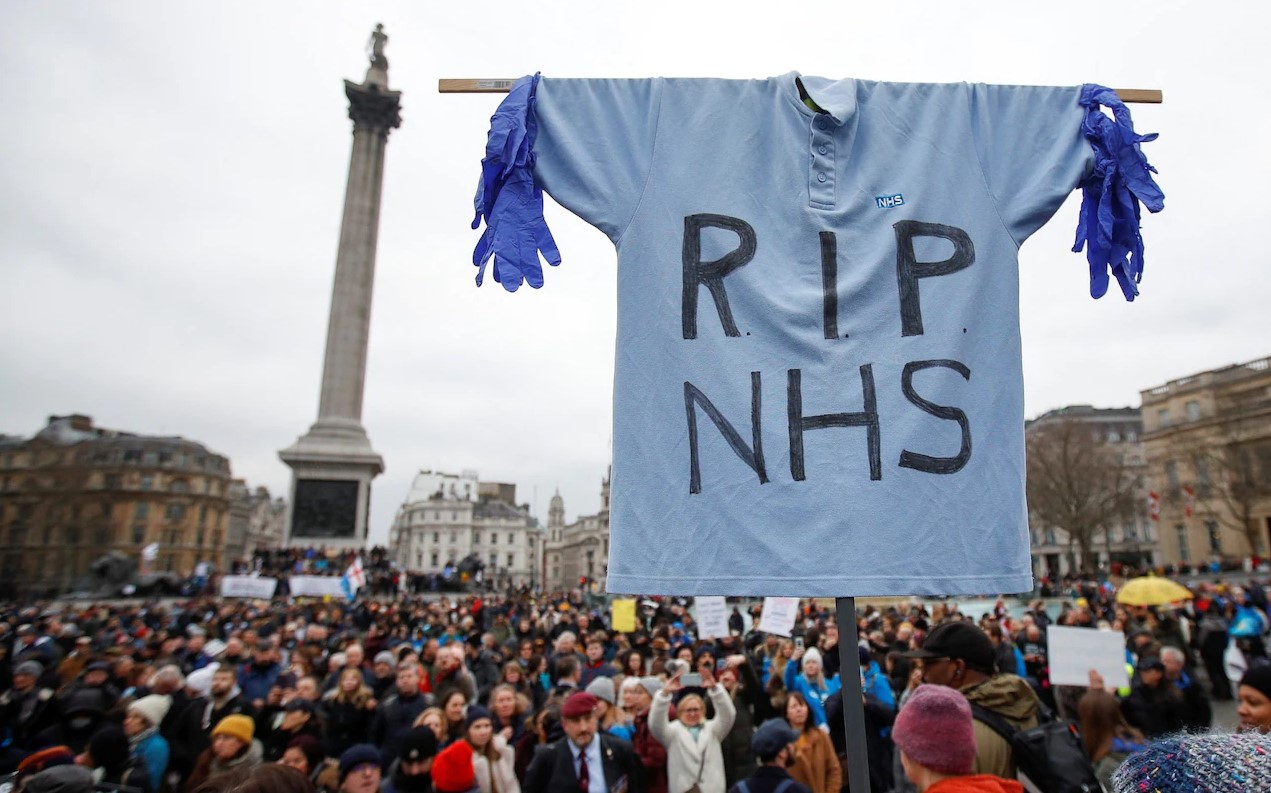This week marked the 75th ‘birthday’ of our sainted anthropomorphised NHS. Observing the relentless barrage of propaganda from the BBC and associated media outlets I have been thinking about the nature of belief systems – how they are formed, sustained and manipulated.
Official lines loop endlessly on the public broadcaster – similar to leitmotifs in an opera or the chanting of a Greek chorus. Endless repetition of the foundational myth: universal healthcare, free at the point of use from cradle to grave, paid for by general taxation. Dire warnings of the threat of American style healthcare bankrupting patients with medical bills. And the excuses – always the excuses: ‘ageing population’, ‘rising demand’, ‘chronic underfunding’ and the rest. There is, as yet no evidence of intention or appetite for a significant change to the model of monolithic socialised healthcare in the U.K.
The pinnacle of absurdity must surely be the bizarre pantomime at Westminster Abbey on Wednesday. Royalty and the bien pensant beau monde gathered with 1,500 ‘NHS heroes’ to thank a presumed deity for bestowing chronically underperforming state-run healthcare on the nation. The Dean of Westminster went so far as to say that “the NHS was, and still is, a glimpse of the new heaven and new earth that is promised”. The poor chap may need to see a doctor – if he can find one. Irony is usually wasted on politicians, but I thought it telling that in the week Wes Streeting suggested we need to stop treating the NHS as a national religion, the leader of his party stood in a pulpit in Westminster Abbey performing a reading from the Bible in homage to the sacred institution. I’ve seen some nonsense in my time, but this was really through the looking glass.
The ‘birthday’ has seen the release of multiple reports, purporting to assess the state of the NHS and provide expert advice on how to repair it. Such reports are usually written with a prior agenda in mind – often with the intention of manufacturing ‘opinion-based evidence’ or to promote vested interests. Sometimes they are written to give the impression that a public body is ‘listening’ or has a plan. Occasionally the purpose is to deflect attention from embarrassing issues or to conceal prior policy mistakes. I find it noteworthy that reports published this week from different sources contain very similar substance. Surely coincidental.
The most eagerly awaited publication was the NHS long term workforce plan. Weighing in at 151 pages, this document is at risk of TL;DR syndrome (‘Too long, didn’t read’). Of course, this may be the intention. I’m always keen for readers to examine source documents for themselves, but in case they very reasonably have better things to do, I will summarise my thoughts below.
Before reading any report, the first thing I examine is the authorship or contributor list. The NHS workforce plan does not have one. There is a lengthy list of bodies ‘consulted’ but no names on the document other than that of Amanda Pritchard, the NHS CEO. This makes me wonder what (and who) the influences were on putting it together.
In common with most governmental reports, the document is slightly disjointed. Being written by committee, the various sections don’t fit together coherently. The preamble is packed with sanctimonious verbiage consistent with the religious positioning of the NHS. The text is long on aspiration but short on specifics – not entirely unreasonable given the unpredictability of the political landscape, but without specific deliverables, it is hard to quantify value. As the eminent 19th century historian Thomas Babbington Macaulay put it: “The smallest actual good is better than the most magnificent promise of impossibilities.”
Headline reporting has focused on the intention to expand the workforce. More medical school places, more nurses, more paramedics etc. Training courses will be shortened to push students into the workforce at an earlier stage. Competencies around prescribing for pharmacists and specialist nurses will reduce demand on GP services. Care will be moved out of hospitals and into the community. Public health will be improved to reduce obesity, diabetes and other chronic disease conditions. At the end there is a slightly bizarre section focusing on emerging technologies such as robotic surgery, AI, genomics, virtual wards, personalised care plans and so on. The lengthy appendices contain lots of detail in relation to the economic models used in generating the substance. I assume this is intended to reassure readers that there is some quantitative analysis behind the document – given the recent track record of governmental modelling I wouldn’t set much store by that. Maybe it will be different this time.
On the upside, the report is at least a recognition of workforce problems by the civil servants who run the system (I don’t think elected politicians have any significant influence). The proposal to reduce duration of medical training isn’t quite as crazy as it sounds at first glance – shorter courses are already successfully provided for graduate entrants with prior experience in areas related to medicine and there may be some benefits to be gained here.
What isn’t mentioned in any significant detail is the ongoing cost – if the workforce is rapidly expanded, the wage bill will also rapidly increase. Given that staff costs are the single biggest item in the NHS budget, it’s a reasonable inference that the taxpayer will be tapped for a lot more cash. Nor is there any mention of who will train these extra medical students and nurses – frontline staff are already pushed to the limit – I can’t see many of them agreeing to take on extra teaching commitments given current industrial unrest. Further, as another recently released report from the Institute for Government points out, NHS productivity has continued to fall in recent years despite huge increases in the number of staff employed.
Maybe it will be different this time.
However the NHS workforce issue develops and whatever multiple agendas are in play, it will inevitably take many years to train the promised extra staff. Meanwhile, demand will continue to increase. The scale of the acute problem has been elegantly depicted by the financial website Bloomberg in helpful graphic analysis of demand/supply discrepancies across the U.K.
The quickest way to mitigate workforce pressures would be to retain senior staff intending to retire. It is clearly a lot more efficient to keep experienced doctors at work than to train complete beginners. According to a recently published GMC workforce report, 15% of doctors are currently taking hard steps to leave clinical practice. The British Medical Journal cites data from NHS business services that the number of GPs and Hospital doctors opting for early retirement has risen by 9.3% year on year from 376 in 2008 to 1,424 in 2023.
I find it surprising that commentary on retention focuses heavily on compassionate management styles but has little to say about the onerous and intrusive regulatory burden imposed on senior doctors by both the NHS and the GMC. My personal observation is that there are two main drivers pushing senior colleagues to retire before their time. The first is excessive taxation, closely followed by excessive regulation. My first suggestion to improve senior retention would be to scrap pointless and infantile mandatory training requirements, reduce the frequency of appraisals and revalidation and build some recognition that doctors cannot be 100% perfect 100% of the time. Not only would this relieve pressure on senior clinicians, but it would actually save money. It might also persuade some people to continue in clinical practice for a while longer.
The NHS workforce plan leans heavily on the optimistic narrative that ‘the machines will save us’. I find this hard to believe. My experience of efficiency-enhancing new technology has usually been that it takes longer than expected to install and delivers less efficiency than predicted. Maybe it will be different this time.
One of the more insightful comments on the workforce plan came from a member of the BMA’s Junior Doctors Committee. Writing on Reddit, Dr. Poh Wang warns his colleagues that a large expansion of the medical workforce will reduce the power of the BMA, damage career progression and probably reduce medical remuneration. He succinctly articulates the reasons the BMA have resolutely opposed expansion of medical school places for many years. It is a well-known economic principle that as supply increases, unit cost generally falls. Simply put, the workforce plan envisages creation of an expanded but lower status medical profession, possibly deployed by central allocation to areas of need (which may occasionally overlap with areas of political priority). I doubt the BMA is as enthusiastically supportive as its official representatives appear.
Overall, my impression is that the NHS workforce plan is a restatement of the establishment’s continued commitment to a centralised state-run health system. Some hints on the thinking behind the plan may be gained from commentary in the Guardian, where several experts in healthcare expand on the opportunities provided by new technology, hint at coercing medical schools to produce more GPs and an expansion of behavioural taxation of certain foodstuffs. I think I’ve heard that before, but maybe it will be different this time.
A further concordant report was released by the Tony Blair Institute. Mr. Blair’s insight also features a heavy emphasis on new technological solutions to enhance efficiency and patient centred care – mainly using the ‘world beating NHS app’ to allow patients to access services provided by both the NHS and private sector. Perhaps Mr. Blair has forgotten his previous experience with NHS technological innovation. For the sake of brevity, I quote from the Lancet in 2011:
If there were an award for the world’s most mismanaged national health project, England’s National Programme for IT in the NHS would be a strong contender, if not outright winner. Started in 2002, Tony Blair’s brainchild has, like the computer in 2001: A Space Odyssey, gone badly wrong… Given the ineptitude that has characterised this project, disaster was almost certain. According to a new report by the Public Accounts Committee (PAC), the Department has failed to get value for the vast sums of money that it has paid contractors.
So, in conclusion, the NHS workforce plan is a lot more of the same. Will the outcome be different this time?
The author, the Daily Sceptic’s in-house doctor, is a former NHS consultant now in private practice.













To join in with the discussion please make a donation to The Daily Sceptic.
Profanity and abuse will be removed and may lead to a permanent ban.